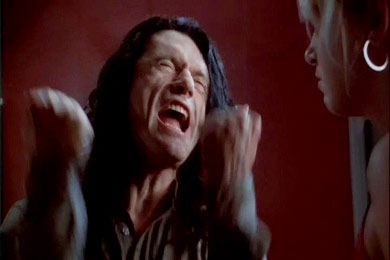I have a few things to write up so may be able to fit in more than one post today. But first things first.

If you haven't seen the emotional, visual and lyrical masterwerk that is Tommy Wiseau's The Room, get on it right now. Plot is immaterial (/non-existent), as instead the story overridingly resonates with the agony of the Hamlet-like Johnny, played by Wiseau, and his Beckett-esque struggle with his cruel fiance Lisa, all set in the claustrophobic atmosphere of their small but luxurious apartment (I would say the claustrophobia is mainly due to the limited budget, resulting in the tiniest sets you've ever seen). Well, anyway, I won't spoil any potential viewers the mind-altering experience of watching it, but I have compiled some guidelines, based on rigorously close watching, studying, and expansion of the Tommy Wiseau Techinque, in order that we might grapple with the genius and possibly bring his irreproachable methodology into our own work, stilted and flawed though we are in comparison. Hopefully as I continue my explorations more will emerge. I think I could get a pretty comprehensive list out of it.
Edit: While researching this post I found another with further excellent commentary - When Good Robots Go Bad
Edit: While researching this post I found another with further excellent commentary - When Good Robots Go Bad
Tommy Wiseau's Guide to Writing, Producing, Directing, and Starring in a Film.
- So that your audience will relate to them easily, give your main characters names that are short, simple and familiar: Johnny, Mark, Lisa ... Denny.
- Never break the fourth wall by looking towards the camera. If you are particularly struggling with this, the best technique is to never fully open your eyes.
- Why try and put into words what can be expressed magnificently through a more subtle expression of feeling, such as a walrus-like croon or some drawn out, throaty moaning?
- Sex scenes are necessary but can be arduous and embarrassing for ingenues and younger actors. Feel free to subtly recycle footage so that excess shooting is not needed.
- It's important to tackle serious issues within your script, such as drugs and cancer. To encourage the audience to autonomously consider these difficult topics long after the film is over, it also helps to never provide catharsis or mention them again.
- Slow jam.
No comments:
Post a Comment